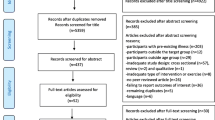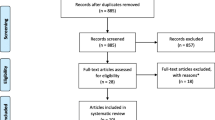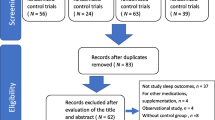Abstract
Background
Adolescence is a developmental period characterised by rapid physical and psychological changes that heighten the risk for inadequate sleep. Fortunately, physical activity programs (PAPs) are an easy-to-do intervention that has been associated with improved sleep outcomes in different population groups. This systematic review aimed to provide evidence to support the effects of PAPs on sleep outcomes among apparently healthy adolescents.
Methods
A systematic literature search was performed in online databases of PubMed, Cochrane Library, and PEDro for all dates up to April 2022. All relevant clinical trials reporting on the effects of PAPs on sleep among adolescents were included using a pre-defined inclusion/exclusion criterion (PROSPERO: CRD42020171852). The methodological quality of the included studies was assessed using ‘specific checklists per design’ (RCTs) provided by the Dutch Cochrane Centre. Qualitative synthesis was used to report the results of the review.
Results
Two RCTs were included and analysed in the review. Both studies were of good methodological quality but lacked blinding. The PAPs in the reviewed studies included mainly aerobic exercises in the form of cross-country running in the mornings, SMS-delivered motivational messages to increase daily step counts, and use of a pedometer and step diaries. Sleep was measured both subjectively by means of sleep questionnaires and objectively using sleep electroencephalographic recordings. Nevertheless, qualitative synthesis is suggestive of an overall positive effect of PAPs on some sleep outcomes in adolescents, albeit with limited to moderate evidence.
Conclusion
PAPs appear to have a beneficial effect on some sleep outcomes among apparently healthy adolescents. Nevertheless, the body of evidence is currently scanty, thus warranting the need for more high-quality RCTs.

Similar content being viewed by others
References
Matthews KA, Hall M, Dahl RE (2014) Sleep in healthy black and white adolescents. Pediatrics 133(5):e1189-96
Chattu VK et al (2018) Insufficient sleep syndrome: is it time to classify it as a major noncommunicable disease? Sleep Science 11(2):56
Ming X et al (2011) Sleep insufficiency, sleep health problems and performance in high school students. Clin Med Insights: Circ, Respiratory Pulmonary Med 5:CCRPM. S7955
Ferrari GJ et al (2019) Subjective sleep need and daytime sleepiness in adolescents. Revista Paulista de Pediatria 37:209–216
McKnight-Eily LR et al (2011) Relationships between hours of sleep and health-risk behaviors in US adolescent students. Prev Med 53(4–5):271–273
Baiden P et al (2020) Association between insufficient sleep and suicidal ideation among adolescents. Psychiatry Res 287:112579
Owens J (2014) Insufficient sleep in adolescents and young adults: an update on causes and consequences. Pediatrics 134(3):e921–e932
CDC. (2020) Sleep and sleep disorders. 2020 15/04/2020 [cited 2020 31/08/2021]; Available from: https://www.cdc.gov/sleep/index.html.
Şekerci YG, Bicer EK (2020) The effect of walking exercise on quality of life and sleep in elderly individuals: randomized controlled study. Turkish J Geriatrics 22:4
Guthold R et al (2020) Global trends in insufficient physical activity among adolescents: a pooled analysis of 298 population-based surveys with 1· 6 million participants. The Lancet Child & Adolescent Health 4(1):23–35
WHO, (2020) WHO guidelines on physical activity and sedentary behaviour: at a glance.
Vanderlinden J, Boen F, van Uffelen JGZ (2020) Effects of physical activity programs on sleep outcomes in older adults: a systematic review. Int J Behav Nutr Phys Act 17(1):11
Richardson C et al (2018) Cognitive performance in adolescents with delayed sleep-wake phase disorder: treatment effects and a comparison with good sleepers. J Adolesc 65:72–84
Lang C et al (2013) Increased self-reported and objectively assessed physical activity predict sleep quality among adolescents. Physiol Behav 120:46–53
Brand S et al (2010) Evidence of favorable sleep-EEG patterns in adolescent male vigorous football players compared to controls. World J Biol Psychiatry 11(2–2):465–475
Luo DM et al (2018) Analysis on the current situation of insufficient sleep and its association with physical exercise among Chinese Han students aged 9–18 years, in 2014. Zhonghua Liu Xing Bing Xue Za Zhi 39(10):1298–1302
Bartel KA, Gradisar M, Williamson P (2015) Protective and risk factors for adolescent sleep: a meta-analytic review. Sleep Med Rev 21:72–85
Bull FC et al (2020) World Health Organization 2020 guidelines on physical activity and sedentary behaviour. Br J Sports Med 54(24):1451–1462
Mohammed J et al (2017) Effect of respiratory rehabilitation techniques on the autonomic function in patients with chronic obstructive pulmonary disease: a systematic review. Chron Respir Dis 14(3):217–230
Mohammed J et al (2015) Evidence for autonomic function and its influencing factors in subjects with COPD: a systematic review. Respir Care 60(12):1841–1851
Baldursdottir B et al (2017) Impact of a physical activity intervention on adolescents’ subjective sleep quality: a pilot study. Glob Health Promot 24(4):14–22
Kalak N et al (2012) Daily morning running for 3 weeks improved sleep and psychological functioning in healthy adolescents compared with controls. J Adolesc Health 51(6):615–622
Tudor-Locke C et al (2011) How many steps/day are enough? For adults. Int J Behav Nutr Phys Act 8(1):1–17
Vanderlinden J, Boen F, Van Uffelen J (2020) Effects of physical activity programs on sleep outcomes in older adults: a systematic review. Int J Behav Nutr Phys Act 17(1):1–15
Desjardins SM (2018) Tanguay-Labonté, The effects of physical activity on sleep among adolescents and adults: a narrative review. J Sleep Sleep Disorder Res 1(2):42
Roche J et al (2018) Obstructive sleep apnea and sleep architecture in adolescents with severe obesity: effects of a 9-month lifestyle modification program based on regular exercise and a balanced diet. J Clin Sleep Med 14(6):967–976
Brand S et al (2010) High exercise levels are related to favorable sleep patterns and psychological functioning in adolescents: a comparison of athletes and controls. J Adolesc Health 46(2):133–141
Chennaoui M et al (2015) Sleep and exercise: a reciprocal issue? Sleep Med Rev 20:59–72
Fabbri M et al (2021) Measuring subjective sleep quality: a review. Int J Environ Res Publ Health 18:3
Dzierzewski JM et al (2014) Exercise and sleep in community-dwelling older adults: evidence for a reciprocal relationship. J Sleep Res 23(1):61–68
O’Connor PJSD (1995) Youngstedt, Influence of exercise on human sleep. Exerc Sport Sci Rev 23:105–134
Begg C et al (1996) Improving the quality of reporting of randomized controlled trials. The CONSORT statement Jama 276(8):637–639
Acknowledgements
We thank Dr Julie Vanderlin of KU Leuven, Belgium, for helping to ensure a comprehensive database search was done by sharing her search strategies and results.
Author information
Authors and Affiliations
Corresponding author
Ethics declarations
Ethical approval
For this type of study, formal consent is not required.
Conflict of interest
The authors declare no competing interests.
Additional information
Publisher's note
Springer Nature remains neutral with regard to jurisdictional claims in published maps and institutional affiliations.
Rights and permissions
About this article
Cite this article
Bello, B., Mohammed, J. & Useh, U. Effectiveness of physical activity programs in enhancing sleep outcomes among adolescents: a systematic review. Sleep Breath 27, 431–439 (2023). https://doi.org/10.1007/s11325-022-02675-2
Received:
Revised:
Accepted:
Published:
Issue Date:
DOI: https://doi.org/10.1007/s11325-022-02675-2




